When I wrote about wood finishing with natural oilsThe initial plan was to treat the 2 finishes, wax and oil, together. However, despite they look very similar, they are different and only by developing each one individually can I make a fair and comprehensive presentation.
Wood finishing with wax has been known and used for a long time. There are situations when it is good to use wax and others when it is not recommended. I think you should be aware of these situations when you want to use wood wax.
Natural wood wax, carnauba wax or synthetic wax
The waxes now used are mixtures of natural and artificial waxes dissolved in solvent. In the past, beeswax was used. Now wax as such is rarely used. It is used in mixtures.
Another natural wax used in wood finishing is carnauba wax, a palm from Brazil. This is much harder and is used for decorative candles and car polishes. It is used mixed with beeswax as a natural wood finishing product.
Commonly found products are mixtures of natural waxes with paraffins resulting from the distillation of petroleum. They are either in solid form, which is more difficult to apply, sometimes requiring special application methods, or in paste form, which is easier to apply.
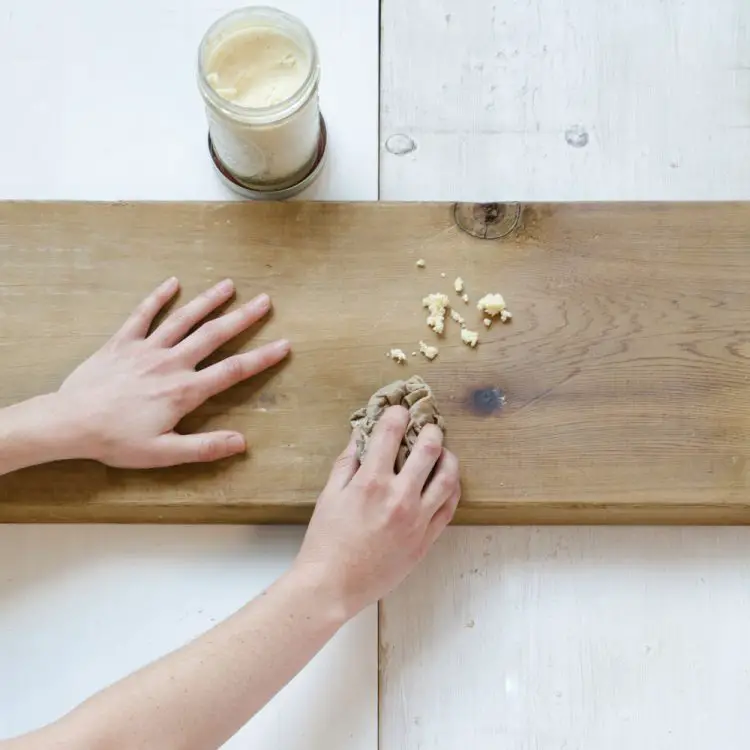
Recommendations when waxing
Contrary to what many believe, wax is not a good choice when it comes to protecting wood. Of all the materials used, it has the lowest protective power against water, mechanical, thermal and chemical actions.
It is true, wax has been used since ancient times to protect wood, but at the time there was no alternative. In the meantime, varnishes appeared, first nitrocellulose, then polyurethane, acrylic, etc., which protected the wood much better.
Oils, on the other hand, protect the wood better than waxes do. Be careful, this is natural wood, not treated with anything else before waxing!
Waxes applied to wood do not form a film like varnishes do, nor do they penetrate into the wood very well like oils. Without a film, resistance to mechanical action is very low. Temperature resistance is also low.
In general, the wax mixture used for finishing will soften at around 140 grd.C. At this temperature, even a cup of hot coffee will leave marks on a wax-finished table.
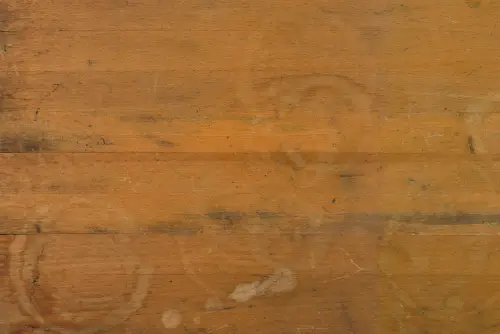
photo source: dummies.com
The waxes are dissolved in solvents. In the past the solvent used was turpentine. Now toluene or white spirit is used. Being soluble in solvents they are very vulnerable when alcohol - a recognized solvent - comes into contact with the waxed surface. And this can happen at any time, by simply spilling a glass of, say, a glass of brandy.
However, there are some special finishes that are waxed directly onto natural wood. These are generally rustic finishes (e.g. French rustic finishes) made on harder, stronger wood, such as oak, al frasin or pine. Hardwood is much more suitable for waxing.
When I was little, I lived in an apartment that had a floor solid oak flooring. I remember that every year, in summer, before going on vacation to the seaside, my parents washed it with "petrosin" (white spirit), then waxed and polished it. It kept very well until the following summer. But it was protected with rugs and we were not allowed to wear shoes in the house.
How to apply wood wax
Apply the waxes with cotton cloth or brushes and brushes. A thin coat is recommended. If necessary, apply another thin coat after the first has dried. In fact, the rule when applying wax is: less is more.
Even if an entire tube of wax is applied, it will be removed during polishing and the amount left will be the same as when a thin coat was applied. Thin coats should therefore be applied and allowed to dry, after which the surface is polished with a cotton cloth or very fine steel wool if the substrate is rougher (rustic furniture, reclaimed wood, structured, etc).
As opposed to applying directly to the wood, wax is a very good choice for applying over a coat of varnish, for refreshing old furniture or for the effect of ageing of furniture. By applying a coat of wax over the varnish, which is then polished, the furniture acquires a very nice touch and a beautiful natural sheen. In addition, any small scratches or imperfections are solved by using wax as a top coat.
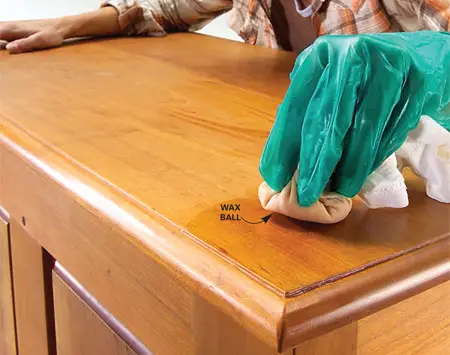
photo source: familyhandyman.com
For old pieces of furniture or old floors, one option to refresh the finish is waxing. In fact, most furniture and floor care products (such as Pronto) contain waxes. The wax is applied after the wooden furniture (floor) has been thoroughly cleaned and then polished.
Wax is used for the ageing (furniture antiquing) effect of wood
Wax is also used to artificially age furniture. Colored wax is generally used, and the choice of shade or color is made so that the effect is as believable and natural as possible.
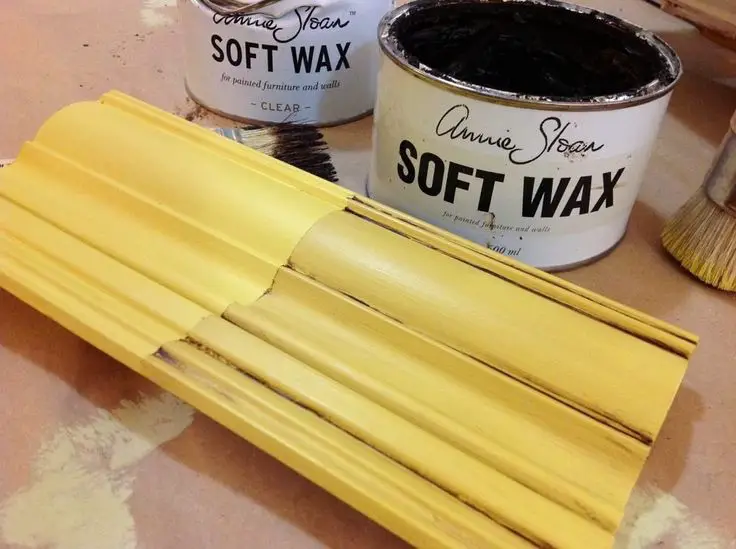
This wax effect looks great on opaque finished furniture in various colors. The wax is applied as usual with a cloth, after which the excess is wiped off and polished. In hard-to-reach places more wax will remain, giving a patina effect.
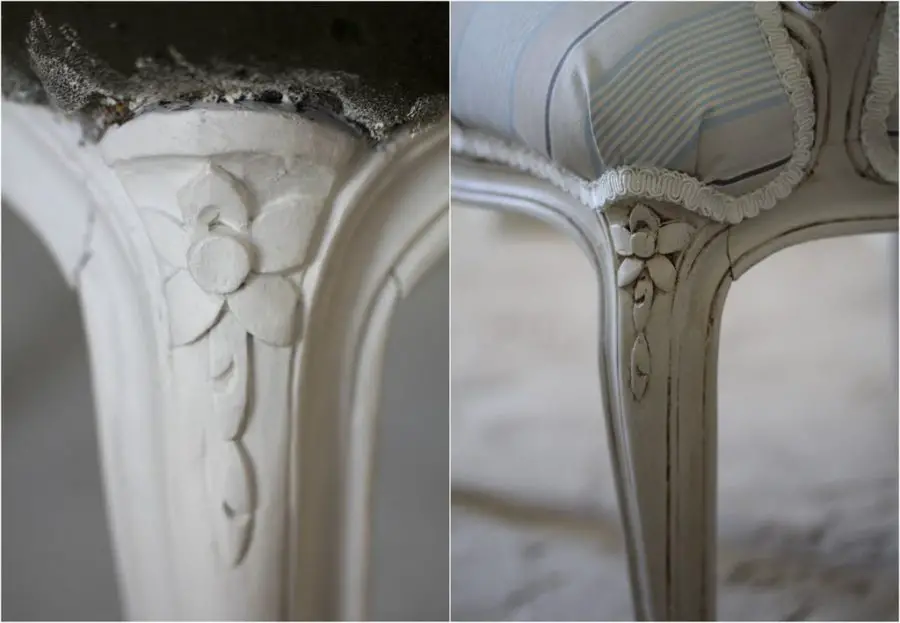
photo source: lilyfieldlife.com
Wax is the final finishing coat
Note that no other finish, not even oil, can be applied over the wax. Therefore, if you want to refinish a piece of furniture that has been cleaned for years with Pronto, you must first remove the accumulated wax layer. Otherwise, the varnish will not catch and will slide off the existing finish coat.
Another recommendation is not to apply wax over waterborne finishes. There is a risk that the solvents in the mixture will irreparably attack the varnish coating.
In conclusion, wax finishing is most useful when waxing over another coat of finish or when it helps to achieve antiqued finishes. It is not advisable to apply it directly to the wood because the protection is very low and nothing else can be applied over the wax.
Your comments are welcome below. Share the article if you find it useful. Thanks.















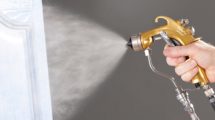
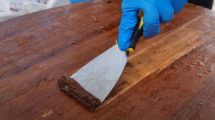













Excellent article! thanks for the information!
I would like to ask, if I buy, let's say, a cabinet, made of spruce wood finished only with wax, because I have no budget for better finishes, but later, I try to apply a commercially bought wax (Borma Waschs brand) or a color created by the same brand Borma, what should I do?
Thank you!
If more time elapses before you do the re-sanding, you should lightly sand the surface with 280 or 320 grit sandpaper or fine abrasive sponges to remove impurities and dirt that have built up over time, then wax smoothly. Wax can be applied on top of wax. But you cannot apply varnish or paint over wax because it has no adhesion. If the wax colour is not also wax-based or if the manufacturer does not tell you that it can be applied over wax, do not risk it because it will not adhere and you will damage it. To apply a normal paint, you should remove the wax as well as possible by repeated sanding and washing with thinner.
Thank you for your appreciation.
All the best!
You are extraordinary, madam!
Thank you and have a wonderful day!
Am I to understand that commercial water-based wax is not such a good solution for an untreated and unfinished tinplate fence?
Hello,
It is less smooth compared to an outdoor oil, but it can be used. You will need to re-spray the finish annually (every 2 years maximum), because the wax, because it doesn't go deep into the wood like oil does, is "washed" faster by rain from the surface of the wood. For the fence, however, it is a better option than varnish, because if cracks appear in the wood, the varnish also cracks and flakes off, whereas wax, not making a film, does not show badly.
All the best!
Hello,
Thanks for the article.
A question, can I apply wax on wood that has previously been treated with soap? I am asking because I understand that it is difficult to apply varnish on that surface anyway and all I have left is oil or wax. Thank you,
Hello,
In general, soap treatment is still given over soap treatment. Wax is a blending material, at least that which is commercially available. It may have solvents or other substances that attack the soap layer or there may be incompatibility between the two layers. In addition, wax changes the colour of the wood unlike soap.
All the best!
Good evening! What do you recommend for finishing a veneer surface used in a hand touching/playing percussion instrument? Thanks in advance!
Good evening,
I'm trying to think logically, because I've never worked with percussion instruments before. I have worked with a musical instrument factory in the past, but it was finishing guitars and other stringed instruments. In your case I think the lacquer should be elastic so that it doesn't break over time due to mechanical shocks. I think the most suitable is a one-component waterborne varnish. It is elastic and the monomer molecules are very well anchored inside the film (if it peels off the bottom layer it takes like a skin). I hope the suggestion is helpful.
All the best!
Hello!
What do you recommend me please for protecting a kitchen countertop made of beech (it is 4cm and is jointed in teeth).
It was given with water-based varnish (3 coats).
Initially I thought of covering it with epoxy resin but it was getting too shiny. I then thought of waxing it but after reading the article I'm not so sure.
Thank you!
Hello,
Wax is not a solution for a kitchen worktop because it is not very resistant, both mechanically and at high temperatures. If you want a high mechanical resistance you can apply a layer of water-based floor varnish on top of the lacquer already given. It is easy to apply (with a trowel) and you will not have any incompatibility problems. Before application, sand the existing coat lightly to ensure adhesion. The floor varnish is also available in lower gloss grades, even very matt (totally no gloss, gloss grade below 10).
From my point of view a protection for such a countertop would have been oil. The look is very natural and it is protected against water, but the protection against mechanical action is less.
All the best!
Without having read the instructions anywhere, I wax-treated years ago (about a dozen or so) a fir kitchen board for kneading and rolling dough, and a beech chopping board. Clean beeswax, applied with a sackcloth, but instead of a solid application, melted with a hot air blower, so that during application the wax was liquid, and the surface of the wood heated up nicely.
Both, and the shredder and the planer, have seen plenty of use so far. The chopper is frequently used for moldy cheese, the planchette I think has even forgotten all the cookies that have been prepared on it. However, on both waxes it holds up, the material being visibly water repellent and beech at least visibly more knife resistant than beech wood not treated in any way, or treated with oil.
My guess, although I didn't take the time to look at the microscope: as the wax was liquid when applied, albeit without solvent, and the wood was well heated, when the wood cooled the wax went deep, at least a few good fractions of a millimetre, into the wood, filling the gaps that would otherwise contain air. That's what keeps the wax from wearing away, and keeps the pores of the wood tightly closed, the wax layer only coming off as the wood the wax is trapped in wears away. If this is the phenomenon, I would expect that even on a fence, furniture surface or other more exposed surfaces solid, solvent-free wax applied in a melted state, with surface heating, would give a fairly durable finish.
Hello,
Your @Gandeala@ was very good. Indeed they use natural melted beeswax to finish the wood. The wood thus finished behaves well over time and is protected against moisture. The problem arises when temperature intervenes. The wax finish is not resistant if hot objects are placed on the wood. For example, such a finish is not recommended for wooden bowls where hot soup can be placed. For fencing it is a very good solution, as is oil finishing. It needs to be refreshed from time to time, but it behaves well.
All the best!
Good evening....an e-mail address please?
Mugur Mindra - Garant Parquet SRL
Good evening.
mihaela.radu@cesbrands.ro
Good evening,
For our own needs, we made a crate from jellied pine planks, without further sanding, mechanical or with glaspapir. The planks had many knots, some of which fell out during cutting and others during assembly. To fill the gaps and straighten the surface I found in the trade a kind of putty-glue, like the one used to straighten car body parts. It's not what I've seen on YouTube (with English or German label), but I hope it works. Drying time 3-5 hours. Afterwards, I wanted to rub the planks with a coloured wax, as I had seen on a video on the same site, to finish the natural (untreated) wood. The wax in the video looks like consistent grease (Vaseline). I couldn't find any commercially available wax, just linseed oil and colourless varnish. In this situation, what do you advise me to do? Should I buy canned wax on eBay?
PS. I will use the crate indoors, in normal temperature and humidity conditions, and waxing is necessary for aesthetic reasons but also to eliminate the roughness of the pine wood, which has not been sanded.
Hello.
With wax you cannot remove the roughness of wood. The wax you saw in the film is probably an abrasive solution that also has wax incorporated. It's a kind of polish. The crate has to be sanded to look good, otherwise you will continually scratch in it. It's not very hard to do the sanding. With fine abrasive sponges you can remove these roughnesses, then apply protective wax, which you can find in any DIY store (wood wax). Buying that wax on eBay will, in my opinion, do the same job (scrubbing with wax is the equivalent of the white sanding I recommended) and the result may disappoint you.
As for the knots, if they were large, filling the remaining gaps with putty will not look very good (there will be large, uniform, non-wood-like stains). Usually these knots are filled with twigs. Basically, a piece of branch the size of the gap is forced into the gap, then cut to be flush with the surface of the wood and sanded. In order not to "sag", the branch should be as dry as possible, and for safety you can first put glue on it and then put it into the hollow of the knot.
Glues are usually used to fill cracks in knots or wood. Carpenters often make their own putties by mixing wood dust (not sawdust) with aracite or nitrocellulose varnish. The mixture is put into the crack, allowed to harden, then sanded.
I hope you find the information useful.
All the best!
Don't forget to subscribe to the printed Wood Magazine! For only 58 lei/year you can find news from
field, you can discover craft ideas or secrets of the trade. We remind you that in the magazine
printed content is different from that on the website. Details in the link below.
Thank you!
https://revistadinlemn.ro/product/abonament-revista-din-lemn/
Hello. I congratulate you for your patience and attention. I also have a question. I painted a pine cabinet with acrylic paint and then painted it with the same type of paint. I would like to protect it after all that effort. My question is with what? Lacquer, oil or wax? The lacquer I used on the inside of the drawers has a sheen to it that I don't seem to want all over it, even if it is water based. Is there an oil or something that won't rub off my paint? Thank you.
Hello.
You can use the varnish you used inside, but with a lower gloss (between 10 and 30 gloss). Lacquers, whatever their nature, can have gloss levels between 0 and 100. Between 0 and 30 are matt lacquers. For example, a 10 gloss lacquer has a natural effect.
I would try colourless wax. It sprays well and has a very pleasant cough. Apply the wax with a rag and spread it well to avoid excess. Let dry until the next day and polish. You can also apply 2 or 3 coats for better protection. Allow to dry between coats (min 8 hours). Polish only at the end. Polishing can be done with a soft cotton cloth.
Good luck!
Don't forget to subscribe to the printed Wood Magazine! For only 58 lei/year you can find out news in the field, discover craft ideas or trade secrets. We remind you that the content in the printed magazine is different from the one on the website. Details in the link below.
Thank you!https://revistadinlemn.ro/product/abonament-revista-din-lemn/
Hello! What can be done with the abrasive side of the dish sponge and detergent on newly laid parquet? changed or is there something to redo it? Thank you!
Hello.
Depends on the floor. If the flooring is laminate, the wood design is a printed image, not real wood. With the sponge you have ruined the design and you can't redo it. You should replace the destroyed board.
If it's laminate, parquet or laminate flooring you should find a similar coloured filler and a hard clear varnish (or paint, depending on how the floor was finished) and it can be repaired strictly on the damaged spot. It is best to call in someone with experience.
All the best!
Don't forget to subscribe to the printed Wood Magazine! For only 58 lei/year you can find out news in the field, discover craft ideas or trade secrets. We remind you that the content in the printed magazine is different from the one on the website. Details in the link below.
Thank you!https://revistadinlemn.ro/product/abonament-revista-din-lemn/
Hello,
I have a question,
I want to make a small gazebo in my garden and cover it with shingles, from what I understand from local craftsmen that shingles are not treated, I would like to boil it in linseed oil, or at least to immerse it in heated linseed oil and let it dry, I could also use car oil but it changes the shade and smell and being more viscous I think it penetrates harder into the wood fiber.
Is it advisable to treat shingles or not? And if so, what do you recommend to keep as much as possible its natural color, impermeability and resistance to sunlight.
Hello.
If the roof of the house has a steep slope there is no need to treat it. Shingles are only treated when the slope is small and the snow is likely to stay on the roof for a longer time. Otherwise, it will resist untreated.
Sicativated (or boiled) and lightly pigmented linseed oil is best. The oil is not resistant to UV radiation and therefore needs to have a small percentage of pigment. The colour changes very little. You can use oil-based varnishes coloured in specific colours: pine, douglas, oak. Drying helps drying. Non-drying oil dries very slowly.
All the best!
Don't forget to subscribe to the printed Wood Magazine! For only 58 lei/year you can find out news in the field, discover craft ideas or trade secrets. We remind you that the content in the printed magazine is different from the one on the website. Details in the link below.
Thank you!https://revistadinlemn.ro/product/abonament-revista-din-lemn/
Hello!
I have a piece of old wood (about 15-16 years old), which I have treated against woodworm*, I have... oiled it with tung oil.I would like to know if it is necessary or possible to give it a wax coating.I have a small can of beeswax and carnauba.
Thank you very much!
Hello.
It is not necessary, but it is possible to apply both beeswax and carnauba wax. I really like the look of wood treated with tung oil and it doesn't look like it needs wax. There are rumours that it maintains and polishes beautifully (gets a silky sheen) when wax is applied over the oil. You can use both types of wax. Beeswax changes colour a little to yellowish, while carnauba wax (easier to apply if emulsion) keeps the colour unchanged. The choice is yours. 🙂
All the best!
Don't forget to subscribe to the printed Wood Magazine! For only 58 lei/year you can find out news in the field, discover craft ideas or trade secrets. We remind you that the content in the printed magazine is different from the one on the website. Details in the link below.
Thank you!
https://revistadinlemn.ro/product/abonament-revista-din-lemn/
[...] fireproofing and against decay, the wood must be protected with varnishes or natural materials (wax, oil). These require regular maintenance. In addition, the house itself should [...]
Hello! Very interesting article! But it doesn't really solve my problem, and I'll explain what it is, maybe you can guide me and help me in this case.
I want to polish some briar pipes. I understand that for this process carnauba wax is recommended. Well, I received a piece of carnauba wax from someone but in solid state, and without mechanical/electronic polishing/polishing tools, without polishing discs, I don't have much to do with that wax or I don't know how to use it. But I noticed that there is also carnauba wax in a softer state, which can be stretched by hand, but I don't know where I can find such wax in our country. Everywhere I go they only give wax for polishing the car. An example of carnauba wax suitable for pipes is shown here https://www.youtube.com/watch?v=F26aZaRohvg but I don't know where I can find something like this in Romania. If you know where I can find it, please let me know.
I also wanted to ask you about olive oil... I have seen that it gives a very good shine to briar wood, and I am thinking of applying olive oil but I don't know if before or after applying carnauba wax. I await with interest your answer!
P.S.: I'm from Bucharest, if you know a place where I can buy natural carnauba wax in a less solid state, one similar to the one in the video, you would help me enormously.
Thanks in advance!
Hello.
The oil is applied before waxing. The water penetrates deep into the wood and protects it very well against moisture. Wax is applied over the oil for even better protection. Wax is always the final coat. Nothing else is applied over it.
Carnauba wax is also available in emulsion form and you can find it in Romania. In Bucharest you can find it at Decoart Store, str.Latina nr.2.
All the best!
Thank you very much for your answer. All the best!
Hello.
If I apply a matt waterproofing varnish and then a 2 in 1 savana varnish on dry pine wood, is it good to apply a wax coat? It is a 2 cm thick pine wood, for which I want to obtain a good resistance in time, reaching 15-20 with a good appearance.
Is resin a good solution for pine fence? Can I apply it over bait and varnish or how else?
Thank you in advance for your reply.
Good evening.
I don't know what waterproofing bath means? Do you mean impregnant? Can you give me an example?
I assume you mean a 15-20 year finish life. You won't be able to have that kind of finish durability with any product without maintenance. Wax applied over varnish can protect for a while, but is removed quite quickly (max 1 year) by weathering. If you go back over the finish year after year you can prolong its life.
If the savannah lake has a warranty of say 5-8 years, it will be hard to extend its life because the resin will crack from within the lake layer. It will slowly start to crack.
I don't know what kind of resin you mean. There are several types. If it is epoxy resin, it is not outdoor resistant so it cannot be used to protect a fence.
All the best!
Good evening! I made a heart of pine wood, on which I gave colorless spray varnish (2 coats so far), and after the varnish dries, I would like to finish with colorless wax Antikwachs Borma.
My question is whether I can apply wax over varnish? Thank you!
Good evening!
Yes, you can apply wax over varnish. But you can only apply wax over wax. Wax is the final coat.
All the best!
Good evening, I would like you to give me some indications; I am the owner of an old wall clock that I received broken and with parts of the box missing, the box has components of fir, pine, pine and cherry, I managed to rebuild it according to the catalog shape.The original wood was not lacquered but it had a special semi glossy finish, I don't think it was given with ,,bait" (the clock is from 1890-1900), could you kindly tell me what to use : bait, oil, wax to get that surface and make it look old ! Thank you !
Good evening.
My guess is it was made with shellac. It's the material that was used a lot back then to protect wood. Shellac also makes a film and has a very nice silky sheen. Unfortunately the application method is laborious and requires some knowledge and skill. You can find out how to apply it from the link below.
If you don't dare to do such a job I recommend you to use oil. The nicest is tung oil, but you can also use Danish oil (a mixture of tung and linseed oil) or even linseed oil. After applying the oil, protect everything with wax and polish it with a soft cotton cloth or a cotton wool to give it a silky sheen.
To make the wood look old you have to make the wood look old by specific methods. Here you really need some experience. You can find more information in our articles on antiquing.
All the best!
https://revistadinlemn.ro/2017/08/18/french-polish-metoda-clasica-de-aplicare-a-shellac-ului/
https://revistadinlemn.ro/2017/03/14/sugestii-pentru-antichizarea-lemnului-si-a-mobilei/
Good evening. I own a chest of drawers made of rosewood/palisander wood that is about 70 years old. The top of this chest of drawers probably had, in a few places, some glue on it resulting in the marks that occur when you peel a sticker off a surface and that glue remains. I have tried various mild solvents but have not been able to remove the stains. Finally I tried it in one place and seeing that it worked I used WD40 which after a few minutes worked and removed 100% stains, but after wiping off there were still, "in the light" white spots as if it had affected the varnish state. Immediately I used olive oil (that I had on hand) to lessen the effect. After the removal the stains remained, I tried different commercial solutions but no result. I intend to try to apply oil/wax (probably wax the surface being varnished), but what do you advise:
- apply wax or oil
- how and with what to clean surfaces before application
- wax/oil to apply only on the countertop or on the whole body, as it would need an improvement, i.e. the countertop, the frame, the sides and the back still have the gloss of the original varnish, but the drawer and door faces have lost their gloss completely
Thank you.
Good evening!
You used an aggressive thinner that affected the lake. More than likely the furniture was finished with nitro varnish or shellac. You should lightly sand the surface with a fine abrasive sponge and apply a thin coat of matt or gloss nitro varnish, depending on how the furniture is. After the varnish has dried, apply a thin coat of wax and polish it. This will protect the furniture from any accidents similar to the one you had.
The oil is only applied directly to the wood in order to be absorbed deeply and protect against moisture.
All the best!
Thank you!
Hello. How can I remove wax from wood? 1 month ago, I gave the wood with tung oil and then with Antikwachs wax, but probably after the name "Antik", the wood got a tinge of old, too pronounced (almost like mold) and does not look very good. I have sanded the surface and would like to wipe it with a warm damp cloth a few times, then after drying s and a few days to apply colorless spraylac. Would that work? Or what do you recommend? Thanks
Hello!
It must be dried with turpentine or white spirit (petrosin). With water you will not be able to remove it, because wax is not soluble in water.
It is mandatory to remove the wax very well because no varnish has adhesion on wax. Wax is usually the final coat.
All the best!
Hello! Do you recommend natural wax for wainscoting and shower? It's spruce panelling and showering not yet treated with anything. What would be the best choice for durability? If you recommend wax, how is the solution prepared?
Thank you.
Hello!
Wax can be used for protection, but oil protection followed by waxing is better. The oil gets into the wood and protects from the inside and the wax protects the finished surface making it last better over time. If you want a very hard surface you will not get it with oil and wax. You need floor varnish.
If you opt for oil and wax, there are products specially made to be applied to floors. Kreidezeit's hard floor oil and wax is one option.
I'm talking especially for floors because they are more tried and tested and need to be more resilient. If the finish is good for floors, it is very good for panelling.
I recommend using commercially available products, not making your own waxes or oils. These are better for maintenance. If you want a better resistance of your floors it is better to use products formulated for this purpose.
Below are some links that might help you.
All the best!
https://revistadinlemn.ro/2017/06/15/optiuni-naturale-pentru-acoperirea-pardoselilor-din-lemn/
https://revistadinlemn.ro/2016/11/01/uleiuri-naturale-pentru-finisarea-lemnului/
https://revistadinlemn.ro/2019/10/10/workshop-produse-naturale-kreidezeit/
Hello, I have restored a pendulum.I applied colourless shellac on the veneered areas by brushing.The result was extraordinary, respecting absolutely all the techniques and all the necessary solutions.How long does this shine last?In the meantime I have also purchased a mixture of beeswax and carnauba wax, if I apply this wax does it keep the same degree of shine or does it get duller?Or what role does this wax have if I apply it over the shellac?
Hello!
The shellac sheen lasts a long time and disappears just because dirt is deposited or very small scratches appear on the surface due to use. The wax mixture can be used for protection. Apply a thin layer of wax to the entire surface and after drying, buff with a soft cloth. It will get a nice silky sheen and protect the surface. The shellac sheen is stronger than the wax mixture. I would leave the pendulum like this for now. If you are pleased with the current look it is a shame not to enjoy it. Especially since, being pendula, it's not very subject to action that will damage its surface.
All the best!
You can also find out more about your favourite topics in printed magazines. You can still subscribe to receive magazines published in 2019 by clicking on the link below.
Thank you!
https://revistadinlemn.ro/product/abonament-2019/
Hello,
I bought a solid wood table made of rosewood. It is not finished, the wood is "natural"... I use it in the living room for table, coffee, dining, and as a desk. I'm thinking I should varnish it with something...but I'd like it not to become glossy, I really like the matt, natural look of the wood. At the same time I'd prefer it to keep its current colour as much as possible, I've seen that waxing it would darken it, however I understand that waxing is not a solution for me. Can you recommend a colourless matt varnish? Thank you in advance, Alin
Hello!
You need varnish with a natural effect. It has very low gloss and the wood looks as if it is not varnished. Lacquers change the colour of the wood a little, it turns it yellow. some change more, some less, but all of them do. There are acrylic varnishes that change the colour of the wood very little. You can usually find them at wood finishing distributors (Sirca, ICA-Lomilux, Renner-KronColor, Sayerlack-Golda, Milesi, Sikkens. Where there are 2 names, one is the brand and the other the distributor).
You can also use wax, but you have to be careful with hot mugs, alcohol, mechanical shocks. In this case you should use colourless wax. The final appearance does not differ much from that of varnished wood and the application is easier than varnish.
All the best!
I'm trying to restore the interior doors of a 1970's house, they are made of pine but have been painted in white oil paint several coats. A carpenter cleaned the paint with hot air and scraped, then sanded and buffed a bit.
I have tried Duraziv 2-3 coats water based varnish (wenge). The idea was for it to look like a matte varnish and not an oil paint, but others were skeptical that it would come out with stains.
What kind of varnish do you recommend or what could I use?
Good evening!
To apply water-based varnish you must clean the overcoat very well. After removing the old paint layer the wood is sanded immediately after the surface has been wiped with a cloth with universal thinner (wet sanding). Use a coarser paper, 80 or 100. After drying it is putty coated with a wood putty and sanded again along the grain with finer paper - 150 or 180. After that you can apply water-based coloured varnish.
To check if stains will come out, you can wipe the entire surface with a damp sponge. The water will reveal any defects.
If you've checked with water, let it dry before applying varnish, even if it's water-based. This allows the wood to absorb evenly.
All the best@
when painting, is it applied on the whole door (a thin coat like the self-painting one) or only where it is necessary?
Wood putty is only used for repairs. Cover the hole or crack, let it dry and sand it.
There are also putties - pore-filling putty - that are applied all over the surface. They are special products, which are applied in factories, with valves and are used to fill the pores of the wood and cover the wood evenly.
In your case it is wood putty and is not applied on the whole door but only where it is needed.
All the best!
https://revistadinlemn.ro/2018/11/13/chit-de-lemn-cum-se-foloseste-tipuri-de-chit/
Thank you, good health
Hello,
I painted some older cabinets in the house with GoodHome paint. In the leaflet it says that after applying two coats of paint, it is recommended to finish with wax or varnish. When is it best to topcoat to increase durability? GoodHome paint dries in 10 days. Is it good to wait for complete drying?
And still, I have the same dilemma as some of those who commented under the article: what do I choose for the finish: wax or varnish? I mention that the furniture is in the living room, one of the cabinets will be near a heating source.
Thank you very much!
Hello!
I have not worked with GoodHome paint, so my opinion is only theoretical. My guess is to let the paint dry completely before applying the topcoat. This will ensure adhesion to the substrate and therefore better resistance over time.
Wax gives a more natural look, but is less resistant to mechanical shocks, persistent moisture or patari (coffee, alcohol, etc). It is therefore not recommended for bathroom or kitchen furniture. Lacquer is recommended for this furniture.
All the best!
Good evening! I have new flat ornaments made of pine countertop painted with Sadolin Lac Gros Translucent in two coats with fine sanding between coats. The varnish is completely dry but not very smooth, has very fine roughness due to the wood grain. I would like to apply a coat of wax and polish with a mechanical polisher. Do I have a chance to get something smoother without roughness or not? What disc should I use, bristle, lambskin, etc.? Thanks very much! Merry Christmas!
Hello!
If the varnish was applied in a thick layer, the roughness may also be from air bubbles or thinner that were trapped in the film because the varnish dried on the surface before they came out. I believe this because you say you sanded the entire layers. In this case the roughness due to the wood grain should have already disappeared.
You can sand with a mechanical sander, but you must use fine sanding paper (400 and up). After sanding apply wax with a cloth, leave 2-3 hours to dry, then polish with a soft cotton cloth. The wax will also protect the varnish layer.
Good luck!
Good evening,
I would like to paint a wooden table made in the 60s. It is lacquered and has small imperfections due to long use.
Can I use a special wax for commercially purchased wood without sanding and removing the varnish?
I found on the furnitureclinics website a package of Wood Cleaner and Beeswax.
Thank you.
Hello!
Yes, it can. You must however clean the table before the dirt accumulated over time. It's easy to do by washing it with water and dishwashing detergent. Wash with a wet, well wrung cloth and then wipe thoroughly with a soft, clean cotton cloth. After the surface is well dusted, wax can be applied. I recommend polishing with felt 2-3 hours after application. It will take on a very pleasant silky sheen.
You have recommendations on washing furniture in the link below.
Good luck!
https://revistadinlemn.ro/2020/10/29/ce-trebuie-sa-stii-daca-vrei-sa-revopsesti-mobila-sau-usile-de-lemn/?fbclid=IwAR0hE0RFzKWb2f_D9S1OQ0QmPoH2_er8Gu9Es8zJSed1aehzFiGebIwkILg
However, the classic chewing of waxes with vegetable, siccative oils offers very good protection. Besides protection, the appearance is much more beautiful.
Good evening, for interior oak doors, waxing is recommended. The doors are finished but not finished yet.. I like their natural color, but for not staining or dirtying the wood I am thinking to protect it by waxing.
Good evening!
It is more resistant to oil them first and then wax them. The oak will look great, darken a little and its natural pattern will show off beautifully.
Leaving doors unprotected is not a viable option. They will get dirty and you'll have to re-sand them to get to clean wood.
All the best!
Hello,
Congratulations on the article!
Please help me with an answer regarding furniture antiquing.
Can wax (as in your example, Annie Sloan soft wax) be used on polyurethane paint? In this case the paint layer is sanded before? Can varnish be applied afterwards?
At an industrial level, what do you recommend for antiquing of this type?
Thanks in advance for your answer!
Good evening!
Thanks for your appreciation!
We take them one by one:
- Yes, wax can be applied over polyurethane paint. The paint does not need to be sanded before
- wax is the final coat, no varnish can be applied over it. Only wax can be applied over wax
- I don't understand the industrial level question. If you mean finishing over polyurethane paint, waxing is not really practiced. For a silky look, satin varnishes with a very low paraffin content are used.
Hello, please tell me what I can do with a solid wood kitchen worktop that has been treated with many coats of commercial wax, which has become sticky on top of the dishwasher because of the steam that comes out when I open the door.. thank you.
Hello!
Wax with heat resistance. The only solution is to clean the surface. You can use a paint stripper or turpentine made from resin wax. Petroleum-derived thinner (turpentine, kerosene, petrol) can also be used, but the smell is heavy, overpowering. After removing the sticky part, wipe the surface thoroughly with thinner. After drying, check if it still sticks. Repeat the operation until the surface is no longer sticky. To prevent moisture from getting into the wood, wipe the top with linseed oil or any other wood oil. The wood should just be wiped with the oil-soaked cloth. The oil does not make a film and if it is not wiped off, the surface will become sticky again. Linseed oil should be boiled or pickled.
Over time, repeated wiping with a wet cloth will remove the very thin layer of oil on the surface of the wood. When the wood loses its oil sheen and becomes dry, wipe again with the oiled cloth. Wiping should be done every 6 months, or sooner if you notice dryness in the wood.
In such situations it is recommended to protect the countertop with steam resistant varnishes (polyurethane varnishes). However, it is now difficult to apply such varnish because it will not adhere due to the wax layer. To remove the wax completely you will have to strip, sand the wood well and wipe with thinner.
I leave below the link on how to do the pickling.
Good luck!
https://revistadinlemn.ro/2022/09/08/cum-sa-cureti-cu-decapant-straturile-vechi-de-vopsea/
https://revistadinlemn.ro/2022/08/04/cum-am-refinisat-cu-lazura-precolorata-kreidezeit-usile-exterioare-din-lemn-de-stejar-ale-bisericii-pitar-mos/
https://revistadinlemn.ro/2022/01/13/uleiul-citric-si-cel-de-terebentina-solventi-naturali-pentru-ulei-si-ceara-folositi-si-pentru-degresarea-suprafetelor-sau-curatarea-ustensilelor/